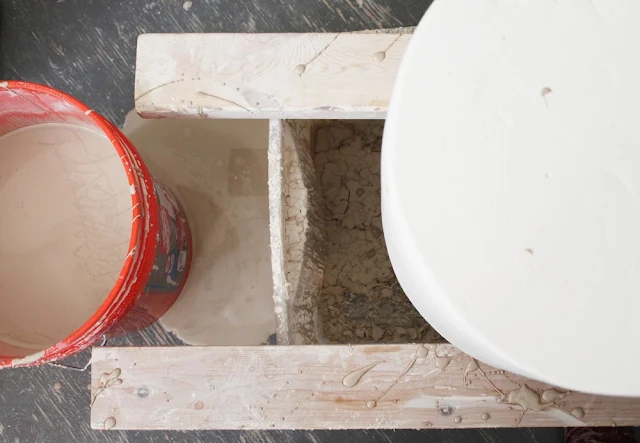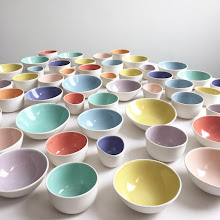I am in NYC for the NY NOW show, and am staying at my dear friends’ house in Brooklyn. M&A have collected my work from the very beginning, and keep it beautifully displayed (and constantly in use) in their kitchen. I love the way they have mixed early (the turquoise) and current gleena in with vintage serving pieces and french cafe o’lei bowls.
I am very grateful for M&A’s continuing support, their encouragement keeps me going and inspired.
how to make a cover for an ice bucket, out of liquid porcelain, hmmmm...
The cover had to be spacious enough for the ice bucket to be removed easily. Making a model is a hard process, made more difficult by the fact that my porcelain shrinks about 10% while it goes through all the firings.
For the ice bucket to fit well, the model had to be at least 10% larger than the final product. Quite a design challenge.
I created a model out of plaster, it is giant, and heavy, and took about two months to get right, the first and second try ending up being too small.
The mold for the cover, also out of plaster, is even larger.
It takes 5 gallons of porcelain slip (liquid) to fill the mold all the way to the top.
It is impossible to empty it out by myself, and I end up spilling the slip all over.
When the cover finally comes out of the mold, it has a very rough edge due to being drained upside down.
While the cover is in the ”leather-hard“ stage, I cut out the handles, and clean up the edges with a sponge.
You can see how much the cover shrinks, the knob of the lid is peeking out on top. It is well below the rim in the previous photo. The carrying handles double as a resting place for the ice tongs.
I made four covers, one for me, and three for the client, Lippincott, a graphic design firm in NYC. The covers are glazed blue inside, and ivory on the outside, to match Lippincott’s other gleena dishes, click here to read more about their custom tableware set.
For the ice bucket to fit well, the model had to be at least 10% larger than the final product. Quite a design challenge.
I created a model out of plaster, it is giant, and heavy, and took about two months to get right, the first and second try ending up being too small.
The mold for the cover, also out of plaster, is even larger.
It takes 5 gallons of porcelain slip (liquid) to fill the mold all the way to the top.
It is impossible to empty it out by myself, and I end up spilling the slip all over.
When the cover finally comes out of the mold, it has a very rough edge due to being drained upside down.
While the cover is in the ”leather-hard“ stage, I cut out the handles, and clean up the edges with a sponge.
You can see how much the cover shrinks, the knob of the lid is peeking out on top. It is well below the rim in the previous photo. The carrying handles double as a resting place for the ice tongs.
I made four covers, one for me, and three for the client, Lippincott, a graphic design firm in NYC. The covers are glazed blue inside, and ivory on the outside, to match Lippincott’s other gleena dishes, click here to read more about their custom tableware set.
Labels:
commissions,
gleena,
process
Subscribe to:
Comments (Atom)













